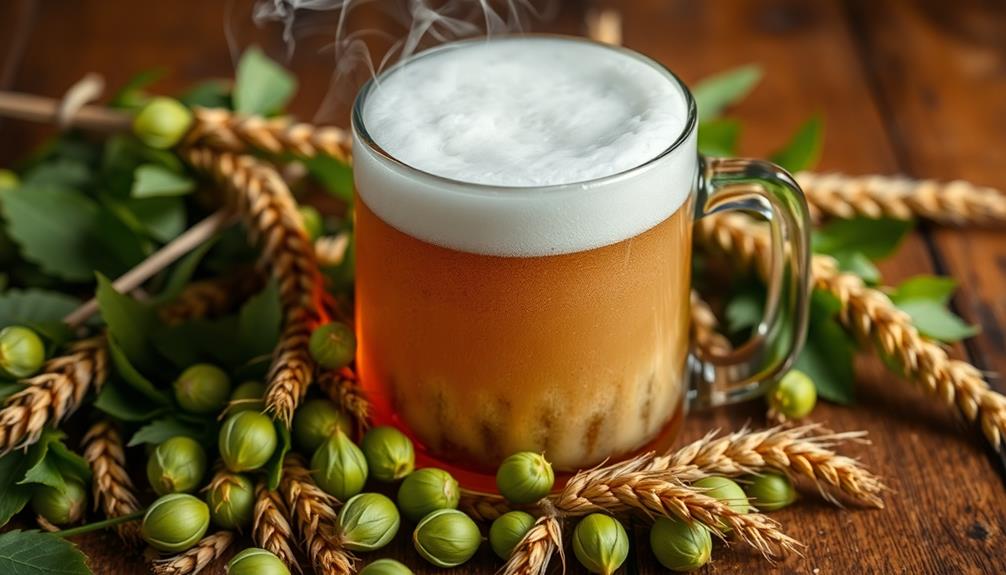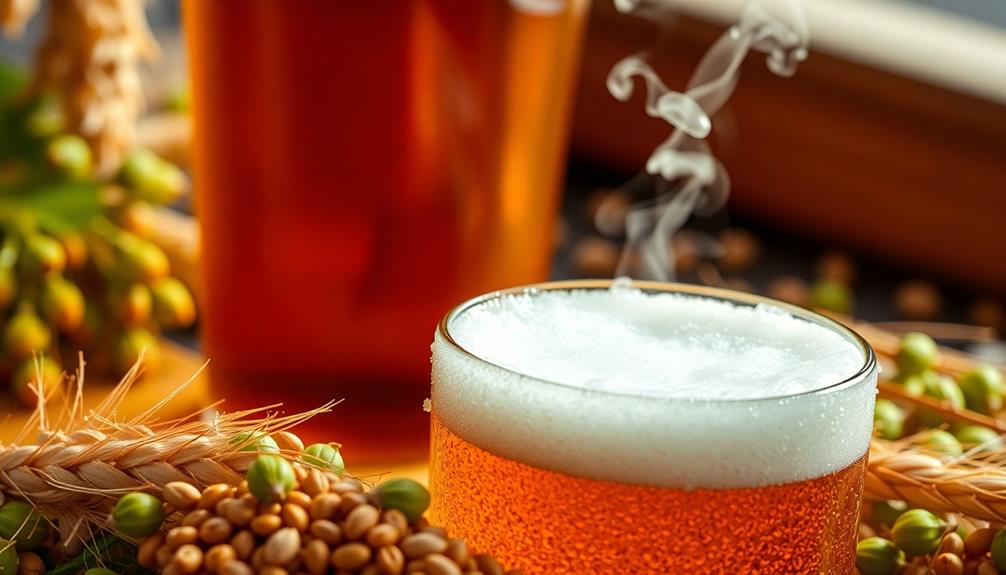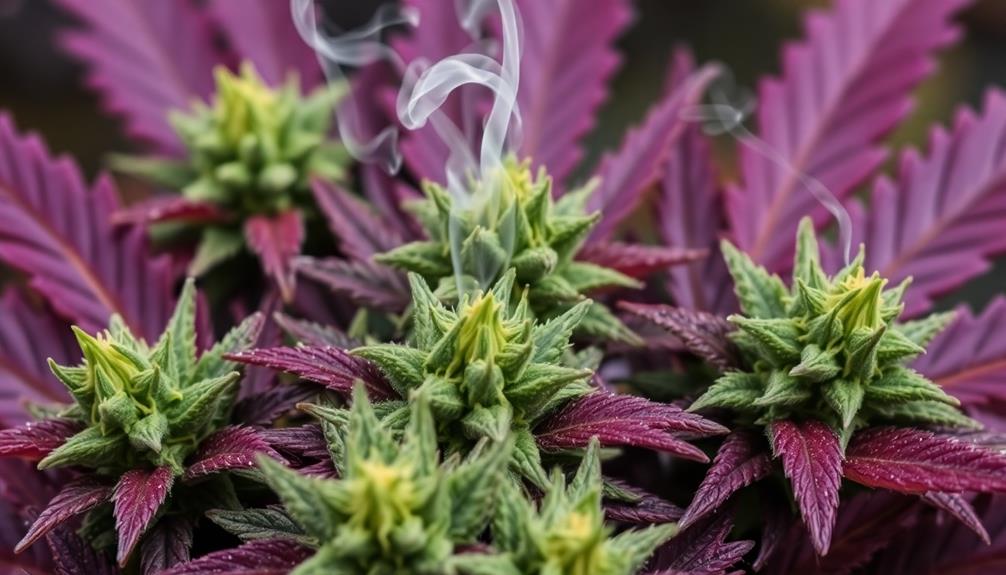Beer smells like a wonderful mix of aromas from its ingredients. You'll often notice malty sweetness from barley, which can be caramelized or roasted. Wheat adds lighter, bready, or fruity notes for a refreshing touch. The hops contribute floral and zesty scents that brighten the experience. Yeast can bring hints of banana or clove, depending on how it ferments. Sometimes, you might encounter off-smells, like a skunky or buttery aroma, which can indicate brewing issues. Understanding these scents can help you enjoy your beer even more, and there's plenty more to explore about its fascinating profile!
Key Takeaways
- Beer aromas are complex, combining scents from grains, hops, yeast, and water that create a unique bouquet for each style.
- Malty scents from barley can be sweet, caramelized, or roasted, while wheat adds lighter, bready, and citrus notes.
- Hops contribute floral, citrus, and spicy aromas, enhancing the overall scent profile of the beer.
- Yeast fermentation can introduce distinctive notes like banana or clove, adding depth to the aroma experience.
- Off-aromas, such as skunky or buttery scents, can indicate brewing issues and detract from the overall enjoyment.
Introduction

When you take a whiff of a freshly poured beer, you're greeted by a complex bouquet of scents that tell the story of its ingredients. Each part plays a role in creating a unique aroma that can make your mouth water.
The grains, like barley and wheat, offer their own distinctive smells. Barley-based beers typically smell malty and roasted, while wheat beers can remind you of bread or citrus fruits.
Hops are another key player, adding aromas that range from floral to zesty. If the brewer adds hops late in the process, you'll notice even stronger scents!
But don't forget about yeast. It's responsible for those interesting notes, which can include banana or clove, thanks to the fermentation process.
While most aromas are delightful, sometimes things can go wrong. Off-flavors, like skunky or rotten egg smells, can happen from exposure to light or fermentation issues.
Description of the Smell

The smell of beer is a vibrant tapestry woven from its ingredients, each contributing distinct notes that create a sensory experience. When you take a whiff, you might notice the malty aromas from barley, which can smell sweet and caramelized or even dark and roasted.
If the brewer used wheat, expect bready and citrusy scents that feel light and refreshing. Hops play a major role too, adding floral, citrus, and spicy notes that can really brighten up the aroma.
If you're lucky, you might catch hints of banana or clove, thanks to the yeast used in the fermentation process. But not all smells are pleasant; sometimes, off-aromas sneak in. For example, diacetyl gives off a buttery scent, while hydrogen sulfide might remind you of rotten eggs.
Oxidation can also spoil the fun, lending an aroma likened to old wet cardboard. And if the beer's been stored in clear or green bottles, you might even get a skunky smell.
Source and Composition

Beer's aroma springs from its core ingredients: grains, hops, yeast, and water. Each of these elements plays a vital role in shaping the scent you notice when you take a sip.
Grains, like barley and wheat, are your starting point. Barley adds malty, caramelized, and roasted aromas, while wheat brings bready, citrusy, and lighter fruity notes that brighten the mix.
Next come the hops, which introduce a variety of aromatic compounds. Depending on the hop variety, you might catch scents like citrus, floral notes, or even spicy hints. These different aromas can change a lot between beer styles, so it's fun to explore.
Yeast also contributes to beer's aroma, with various strains giving off unique scents such as banana, clove, or pepper. These characteristics are influenced by the fermentation process, so the conditions matter too.
Typical Scenarios or Environments

Sipping a cold beer in a lively pub or under the sun at a festival can transform your sensory experience, making aromas more pronounced. The environment plays a huge role in how beer smells. For instance, in a cozy pub, the warm atmosphere can enhance the malty and caramelized scents, while the bright sun at a festival might highlight the citrusy and fruity notes from wheat.
Different beer styles, like IPAs or stouts, each have their unique flavor and aroma profiles. When you're enjoying a fresh brew, you might catch hints of hoppy citrus or rich malts.
However, if beer is exposed to poor storage conditions, like light or heat, it can develop unpleasant aromas; sometimes, beer smells like rotten or skunky due to these factors.
The fermentation temperature and the yeast during the fermentation process also matter. Wild yeast can create funky, sour notes, while standard yeast may bring out fruity scents like banana or clove.
Emotional or Cultural Associations

Throughout history, beer has woven itself into the fabric of social and cultural gatherings, evoking feelings of nostalgia and celebration. When you take a moment to enjoy the smell of beer, you might find it connects you to emotional memories. The aromas can remind you of special times with friends or family.
For instance, the fruity notes in a wheat beer may bring back refreshing summer experiences, while the rich scents of darker beers might remind you of cozy winter nights.
Beer culture varies greatly across the globe, showcasing local brewing traditions and unique ingredients of beer. Each type of beer tells a story through its smell and taste, linking you to regional identities and shared moments.
As you explore different types of beers, pay attention to how the olfactory experience adds to your enjoyment. The smell of beer can spark conversations, enhancing the tasting experience and making it more memorable.
Health or Safety Considerations

While the emotional connections to beer can enhance your appreciation, it's important to remain aware of potential health and safety concerns related to its smell. Certain odors can signal problems that might affect your health.
For example, if you detect a buttery aroma, that's likely due to diacetyl, which points to fermentation issues. Similarly, a sulfur smell from hydrogen sulfide can indicate stressed yeast or contamination.
You might also notice a sweet corn aroma, known as Dimethyl sulfide (DMS), which suggests poor brewing practices. If you catch a metallic smell, reminiscent of iron, it could mean the beer has come into contact with contaminated equipment or poorly stored ingredients. This smell can pose real health risks.
Lastly, if your beer has a lightstruck smell, often described as skunky, it indicates light exposure that has degraded the product. Consuming beer with these off-odors mightn't be safe or enjoyable.
Always pay attention to what your senses are telling you, and if something seems off, it's best to skip that brew and choose a fresher option!
Final Thoughts

Understanding the intricate aromas of beer can greatly enhance your tasting experience. When you take a sip, you're not just tasting; you're also smelling! Different grains like barley and wheat contribute unique scents. Barley brings malty, caramelized notes, while wheat adds bready and fruity aromas.
Yeast can impart additional layers, like banana or clove, which enrich the finished beer's profile. Hops and malt play a crucial role, too. Hops add delightful citrus, spice, and floral notes, making beer smell amazing, especially when added late in brewing.
If you're exploring sour beers, expect tart and fruity aromas from wild bacteria like Lactobacillus. However, keep an eye out for off-flavors in beer. Bad fermentation practices can lead to unwanted scents, like diacetyl or rotten eggs, which can spoil your experience.
Frequently Asked Questions
How Do You Describe the Smell of Beer?
When you describe the smell of beer, focus on its unique aromas. You'll notice malty sweetness, fruity notes, and sometimes floral or spicy hints, which all combine to create a complex sensory experience.
How Do You Describe the Smell of Stale Beer?
When you encounter stale beer, you'll notice a musty aroma, perhaps reminiscent of wet cardboard. It might even smell skunky or metallic, with hints of sweet corn, leaving an unappetizing impression on your senses. The taste won’t do much to redeem it either, often falling flat with a dull, oxidized flavor that lacks any of the crispness or depth expected from a fresh brew. It can linger on the palate, leaving an unpleasant aftertaste that might remind some of what bud rot smells like—earthy, damp, and somewhat moldy. Overall, it becomes clear that this beer has long passed its prime, making it far from enjoyable.
Can You Smell Beer on Someone's Breath?
Yes, you can smell beer on someone's breath. The aromas vary based on the beer type, often revealing malty, roasted, or fruity scents. It depends on how much they've consumed and their individual metabolism.
Why Does Beer Smell Funny?
Beer smells funny due to fermentation byproducts. You might detect buttery diacetyl, rotten egg hydrogen sulfide, or sweet corn DMS. Light exposure can create skunky aromas, while oxidation leads to that unpleasant paper-like scent. Additionally, certain bacterial infections during brewing can introduce sour or musty aromas, further compromising the beer’s quality. Like identifying moldy weed by smell, where a damp, earthy odor is a key indicator, catching unusual off-scents in beer can help you recognize when something has gone wrong. Proper storage and serving practices play crucial roles in preserving a beer’s intended aroma profile.









